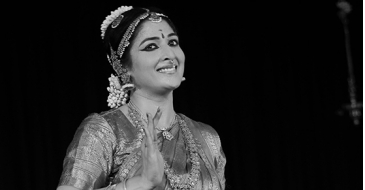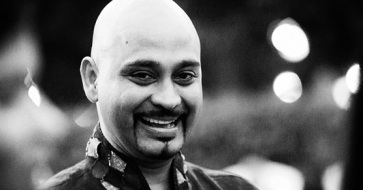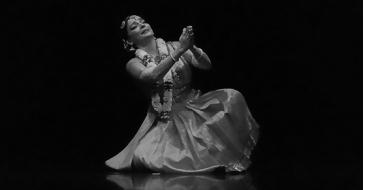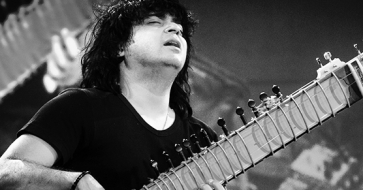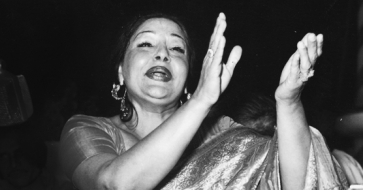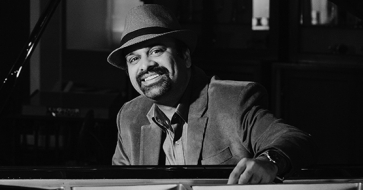Let’s start with Duet; your pet project that you launched last evening… What was the trigger for the album?
The trigger for this album was from a deep introspection into what the voice means to me and how it is understood in the context of Carnatic music.
As a student of music, you predominantly learn and practice in isolation. As a result, the mind and the ears are used to receiving, assimilating and responding to only the sound of your voice. When you sing a concert for the first time, you hear your voice along with fresh sounds from instruments that add new layers while following the (your) voice or offering support. The artiste sitting in the center decides the structure, content and musical flow of the concert while the other artistes on stage respond spontaneously. In a sense, the vocalist predominantly remains the driving force. However, over the years as you gain experience and perform extensively, while getting more comfortable and confident on stage, you get accustomed to the conventional idea of the voice and do not think of the voice as an instrument that can play multiple roles in a concert. Of course, there’s a great deal of sharing; a give and take between the artistes that happens on stage, but it isn’t the same as reacting to something the violinist or the percussionist has lead with, where the voice is then seen in a supporting role.
For me, these ideas were first challenged when I got together and practiced or jammed with my friends, who effortlessly expressed themselves through their instruments with ease and conviction, in a way I had never seen on stage. In these sessions, the roles were reversed and the music suddenly seemed alive and dynamic. Such environments where the voice is heard either in isolation or with just the mridangam or the kanjira challenged my idea of the voice within the framework of this genre and made me question the way I perceived its role.
I’d like to think that that was the starting point of the album.
And when was this?
Well, to be honest, this thought has been brewing in my head over the last three or four years. I’ve been investigating the voice, its form, its function, its facets and how it can find expression in ways that are interesting and challenging.
It helped that around the time I was toying with this idea, a friend was working on a project that was essentially comprised of instrumental tracks, except for one where he wanted to add my voice. It was a famous composition Akhilandeshvari in ragam Dvijavanthi. My violinist friend, Rajeev Mukundan had already played this track and all they needed was for me to respond to the violin and add a voice element to it.
It was an experimental album and the truth is, I didn’t know the song then. I looked up the lyrics and sang exactly what he played. He played the song with a sense of conviction that came from his own learning and practice, and I had to respond with sensitivity to his artistry and aesthetic, something that I was not used to doing.
This recording allowed me the possibility to do the exact opposite of what happens on stage. All I did was to react to his sound, his modulation, his emotion and what a learning it was!
As artistes, we love to be in the limelight, so it takes a lot to relinquish the centre spot and move to the side, so that artistes who are seated behind can get their pride of place
It was completely spontaneous and extempore, is it?
Absolutely! And I think the beauty lies in the fact that it developed and moved organically. As a result, it’s the violin that begins, leads, and calls the final shot.
And what did this shift in dynamic entail for you?
It meant that I had to be way more conscious and sensitive to his artistic impulse, feel and intensity that he intended for the music to create. In a sense, I had to get into his skin for a change, which was a very different experience for me. To be utterly honest, the concert arena doesn't really require the singer to dive deep into the musical sensibilities of another artiste, because the singer is always driving the collective musical direction of the concert. Such collaborative efforts give them an equal creative platform to express freely. I personally enjoyed the spontaneity that came out of this collective spirit, and is a choice that I am more consciously beginning to make.
Is there therefore an attempt to topple the very premise of the concert construct?
Not deliberately, but yes. It takes the onus of the concert being driven by the person in the center, and places it on all the artistes on stage. Every artiste takes collective ownership and responsibility in a collaborative, shared vision of the entire experience in a way that is more profound.
When did all this begin?
In 2018, I toured the United States for three full months with Rajeev, Praveen (Sparsh) and Anirudh (Athreya) where we discussed a lot of these ideas together. Being on tour, with concerts scheduled only on weekends, offers a lot of time and space to leisurely ideate through the week. The concerts in America are typically more than three hours and the audiences are extremely receptive and engaged, so it gave us a lot of opportunities to explore and experiment freely.
We tried to re-imagine and re-interpret the form and format, visually and aurally. And for a change, I was not sitting in the centre. There were so many people who came to us backstage and said that we worked great together as a team and that is exactly what I was looking for. Because the truth is, in every concert, every single artiste is equally invested and contributes immensely. It was also hugely humbling for me to acknowledge them as equal partners in this process while moving out of my comfort zone.
I think this is where it all began. I started thinking about how to pair the instrument and the voice, what are the different roles the voice can play; how can I complement and share without overruling, in a sense….
It dawned upon me then that I had to make an album that would explore all of these nuances.
How did you construct the album?
I knew that the Akhilandeshvari track’s beauty lay in the fact that it had emerged organically. But for the album as a whole to work and translate this complex idea of the voice, it was imperative that each piece was conceived and rendered with clarity in vision.
I had to expand my horizon and think about the minute intricacies of tone and texture of each of these instruments and try to understand the qualities that made each of these artistes special. The entire process was an adventure in exploration and discovery.
In fact, the album has a piece that is a dialogue between the voice and the mridangam, largely based on the structure of a thani avartanam. Interestingly, it has been composed in a way that allows the voice to explore the rhythm within the music and for the mridangam to interpret the arithmetic with music in mind.
If you look closely, there’s an intrinsic rhythm even when I sing a raga alapana, which is defined not only by the raga but also the composition that follows it. A sedate Mukhari raga alapana for a composition like Muripemu and a sprightly Bilahari raga alapana for a composition like Paridanamichite are fundamentally different in pulse and gait. With that in mind, Praveen and I constructed the piece in a way where the music acts as a counterpoint to the volume, tempo, intonation and flow of the rhythm. We have created this connecting thread by picking ragas that convey this idea through ragam, thanam and svaram with the occasional use of rhythmic syllables.
As complex as this process sounds, what you will finally hear is an entire thani avartanam between the voice and the mridangam; sometimes, you will only hear the voice, sometimes just the mridangam; suddenly, there is an overlap; numerous exchanges and a multitude of ideas and emotions that tumble along.

What are the other instruments you have collaborated with?
This album presented a unique opportunity to work with instruments and artistes whom I don't normally perform with. Apart from the violin, mridangam, kanjira, ghatam and morsing, this album also features the flute, veena and nagasvaram. The final track features all of them in one section each, which turned out to be extremely special.
Every track in this album was a test, because it features the voice and an instrument in isolation. In other words, there is nowhere for either of us to hide. I'd like to say that the many interactions, conversations and at times, even arguments that we all shared were stimulating. I've learnt a lot through this process from each and every one of them, and have been forced to confront many of my perceptions, like the one I held about the morsing.
That sounds interesting; talk to us about the morsing track...
The morsing is an instrument that is largely misunderstood, and I think there are many contributing factors. The fact that it is not often seen on the concert platform, the notion that it has a very sharp and strong sound that can be harsh, and the misconception that it cannot offer contrast and is limited in scope. Given the size of the instrument, it may also be visually at a disadvantage as it is generally concealed within the palm of the artiste where the felicity and command over the instrument is hidden from sight. I held a lot of these views too.
It was only when I worked with Sai Subramaniam, a fabulous morsing artiste, that I truly understood the instrument, its potential and its capabilities. It can significantly enhance the music once the instrument's space, advantage and limitations are understood. From being thoroughly ignorant about the instrument, to understanding and appreciating its uniqueness, the sound of the morsing has completely captivated me and changed my perception of it. This interaction has forced me to re-imagine the idea of the instrument, and I must say that I'm a changed person.
When an artiste trusts his vision of the art, and chases the artistic expression that can emerge from the complete surrender to this idea, that is when art is inspired, truly transcends boundaries and makes a lasting impact. It is important for me to constantly allow myself to experience this kind of artistic vulnerability to keep my art alive
Albums like these also put you at risk of being judged, right?
Artistes go through different phases where we question our own professional standing, our relevance, or whether we are valued. These thoughts, though maybe relevant to the artiste, are extraneous and irrelevant to the art itself. External criticism cannot and should not discourage an artiste from following their instinct. In a very real and practical sense, I am taking a risk by doing this album. Success is never guaranteed. But, it is important to also remember that I am not the only one taking this risk. Artistes working with me on this album are putting their professional reputation on the line to create something special.
In a sense, you are okay to allow people to recognise your vulnerability?
There are many different kinds of vulnerability. Being artistically vulnerable is different from being professionally or emotionally vulnerable. So how do I define my vulnerability? When an artiste trusts his vision of the art, and chases the artistic expression that can emerge from the complete surrender to this idea, that is when art is inspired, truly transcends boundaries and makes a lasting impact. It is important for me to constantly allow myself to experience this kind of artistic vulnerability to keep my art alive. It is difficult to pinpoint the exact moment when this happens. But, even if it is tapped into for a fleeting second, there is energy, almost electric in nature, which you can feel between your fingers, and even almost touch!
Is this album also a statement in hierarchy in some sense?
I firmly believe that when our actions are aimed at making a statement or proving a point, it ends up being shallow and frivolous. The arts is a reflection of society and the arts world is not different. Whether it is gender, social, political, artistic or power hierarchies, they are all ingrained. As rigid as these structures are, it is great to see that these lines are slowly blurring and the power of the status quo is being challenged among the younger generation. As artistes, we love to be in the limelight, so it takes a lot to relinquish the centre spot and move to the side, so that artistes who are seated behind can get their pride of place. I perceived this change to be a minor adjustment until I spoke to these artistes and understood the impact it had in terms of their involvement and collaborative spirit. I too had to deal with and confront this issue throughout the album. The audio engineer who worked on the first track found it curious and was quite frankly baffled that I asked for the violin to have more volume and presence than my voice, given that he was the lead. There were other times when I had to acknowledge the fact that this is an equal partnership and agree to work on ideas that were different. This album is a product of these deliberations and has been a huge lesson that has sensitised me to all of these things happening around us in everyday life, that we take for granted and brush aside.
How many tracks make up the album?
Nine

And do you have music videos for them all?
No. There will videos for only three of them.
From the sound of the album, I feel like it’s as much about the process as it is about the outcome. But it’s also a very nuanced idea; so how do you intend for the common listener to be able to access the many layers that have gone into its construction and thought?
For me, this album comes from a place of introspection where I’m re-discovering the sound of my voice in relation with these instruments, which is very different from what I have shared with these instruments on stage all these years. The focus therefore has been to explore this relationship of sound but not at the cost of being or becoming merely an experimental, intellectual or cerebral album.
Irrespective of the compositions we present, I’m curious to see the impact it has on people. I’ve also been very conscious to ensure that the music we are creating truly represents the aesthetic and emotional quotient of the art form even if the sound is new. For someone who perhaps is not interested in engaging with the process or the grammar, the music must still touch their soul.
Would you say you’re trying to find interesting openings, which in some sense are an extension or reflection of your inherent identity as a human being and find how it resonates with your musical identity?
I believe that in art, one cannot lie. The moment an artiste is untrue or dishonest on stage, the purpose of art is lost. Because art, at the end of the day, is a complete representation of who you are. Every artiste has to take responsibility to be completely true to themselves and their work. It’s almost like holding up a mirror to yourself for the world to see and experience with you.
This utopian idea is a difficult thing to achieve in practice though, especially when the sound of Carnatic music is sort of trapped between a sense of nostalgia and the idea of the present. Many times, we do make musical compromises and artistic sacrifices in order to make a performance more successful. So, where do those choices lie?
Over time, I find myself leaning more towards choices that are driven by music rather than performance. I strongly believe that the intensity of my engagement with the art form will ultimately translate into an experience for the audience that is distinctive.
You spoke about being musically driven and to not be performance-centric. Do you feel that you are at a certain phase in your life to be able to say that; also the fact that you are a full-time musician allows you the luxury to be able to delve into your music, with time and leisure?
Most definitely. It is after years of actively learning, performing and having reached a certain stage in my professional career that I have the courage to make such choices.
Actually, the fact that my livelihood depends on my professional success might only act as a deterrent from taking this chance. Every risk comes with its own set of pros and cons. If I choose to take an entirely new artistic direction, then I must also be prepared to face failure. It is definitely a tough decision.
On the other hand, for someone who has a full-time job and is pursuing music on the side, I often think there is a sense of financial security, which maybe allows them the freedom to take these chances. So I guess, there are two sides to the coin.
But it’s true that having made a conscious choice to be a full-time musician, I have more time on hand to explore a wealth of musical ideas throughout the day. There is more space - physically, mentally, artistically - to pour into my art. I am, in a sense, constantly with my music.
Every track in this album was a test, because it features the voice and an instrument in isolation. In other words, there is nowhere for either of us to hide. I'd like to say that the many interactions, conversations and at times, even arguments that we all shared were stimulating
How important is the process?
It is extremely important to go through the entire process, from rigorous training of the basics, learning the pedagogy and many compositions, gaining a strong grip over the various aspects of improvisational singing to performing concerts and working within the existing structure. It is imperative to have a solid understanding of the form before trying to expand horizons or attempting genre-bending work. Venturing into a more abstract space without going through this process is extremely dangerous, in my personal opinion.
Do you also listen to a lot of music?
Absolutely. Listening is an art, and I strongly believe that listening to music has been one of my strongest tools that have contributed immensely to my aesthetic and practice. It is almost like a meditative process.
You know, I’ve heard a lot of people say they practice seven hours or so a day. To be honest, I’ve never done that in my life. I can go upto a few hours at a stretch but I’m always listening to music and I can do that for hours on end. And when I say listening, I don’t mean while driving or reading a book; I actively and consciously listen to music, every single day. I use the word "active" consciously. Casual listening is very different from listening with intent to absorb. The credit for that goes to all my teachers.
My mother Sudha Raja, who was also my first teacher, always made it a point to play different cassettes of yesteryear greats at home, and consciously created an environment that was conducive to absorb and assimilate.
Over time, I find myself leaning more towards choices that are driven by music rather than performance. I strongly believe that the intensity of my engagement with the art form will ultimately translate into an experience for the audience that is distinctive
Sulochana Pattabhiraman Maami without a doubt was the one who re-kindled my interest in music. She cultivated this habit in me, in 2001, when she strictly made sure that I attended every concert possible for the large part of that December Season. She said, “I don’t care what you do, I want you to go to every concert. It doesn't matter if you don’t know the song, ragam, talam, composer, but I want you to write everything down, and bring it to class.” That experience was so revealing and refreshing honestly. That was my initiation into listening to live concerts.
The other defining moment was when I joined my guru, T M Krishna in 2003. In the second or the third class, he gave me a bunch of CDs and said, “Go home and listen to all these artistes”. I was instantly intrigued and curious. Over the course of the next year or so, he also taught me how to intently listen to the music of these greats and learn from them. I was thoroughly inspired and allowed all of their music to shape my early years as a student of music; sometimes, soaking in it for months on end.
Interviewed by Akhila Krishnamurthy
0 comments Comments




